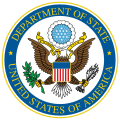Consulate General of the United States, Guangzhou
| Consulate General of the United States of America, Guangzhou | |
|---|---|
| 美国驻广州总领事馆 | |
 Seal of the United States Department of State | |
Incumbent Lisa K. Heller since August 2021 | |
| Formation | 1843 |
| Website | china |
| Consulate General of the United States, Guangzhou | |
|---|---|
Hanyu Pinyin | Měiguó zhù Guǎngzhōu Zǒnglǐngshìguǎn |
| Yue: Cantonese | |
| Jyutping | mei5 gwok3 zyu3 gwong2 zau1 zung2 ling5 si6 gun2 |

The Consulate General of United States, Guangzhou (
History of the consulate
Beginning
The beginning of the American consulate in Guangzhou dates back over two centuries to the founding years of the American republic, even before
Traders, treaties, and diplomats
At that time, Chinese authorities
Aside from Guangzhou, U.S. Consulates were present in South China in the other opened ports of Fuzhou and Xiamen. However, due to a parsimonious and semi-isolationist U.S. Congress, these consulates frequently remained unoccupied. In fact, British and German officials were often asked to represent U.S. interests. This continued until the mid-1880s when the Shanghai Consul General began administering all consular services in China. At other times, the U.S. Consulate in Guangzhou also shared this responsibility.
Years of turmoil and change
With the concurrence of the British government, the U.S., in 1873, built a consulate on
While life on Shamian was peaceful and stable, life off of the island for the Chinese was not. Increasing dissatisfaction with the Qing Dynasty led to protests and its
Reopening
In the wake of the landmark visits of Secretary of State Henry Kissinger and President Richard Nixon, the United States and China formally re-established diplomatic relations on January 1, 1979. According to an agreement, each country was allowed to set up two consulates. The United States chose Shanghai and Guangzhou (China chose San Francisco and Houston). On August 31, 1979, almost 30 years to the day that Consulate Canton had been closed, Vice-president Walter Mondale unveiled the seal for the new U.S. Consulate Guangzhou on the 11th floor of the Dongfang Hotel at 120 Liu Hua Road. Richard L. Williams was appointed the first Consul General in China since 1949. In April 1990, the Consulate returned to Shamian Island when the new Consulate Tower, built on reclaimed land near the Pearl River, was completed at 1 Shamian South Street, next to the White Swan Hotel.
Since reopening, the consulate's efforts have focused on two main issues: immigration and commerce. As South China has historically been the home for most
Meanwhile, the economic growth in South China, and particularly the Pearl River Delta (or PRD, the region surrounding the Pearl River from Shenzhen to Zhuhai) has been extraordinary. Since 1980, the GDP of the Pearl River Delta region has grown annually at 16 percent and about 1/3 of all of China's global exports originate from this area of 35 million people. In view of such growth, in 1985 the Department of Commerce opened a Foreign Commercial Service Office and the Department of Agriculture opened a Foreign Agricultural Office in the China Hotel on Liuhua Road. The public affairs section, located in the Garden Hotel, distributed press releases and backgrounders on American policy, organised press conferences and other media events.
Attack accusations
In May 2018, an American state employee reported sickness after hearing disturbing sounds.
New consulate compound

The new consulate-general compound is located in
See also
- List of diplomatic missions of the United States
- Sino-American relations
- Americans in China
References
- ^ a b "Consulate Guangzhou History". Consulate General of the United States Guangzhou. Archived from the original on May 1, 2013. Retrieved June 24, 2013.
- ISSN 0362-4331. Retrieved June 7, 2018.
- ISSN 0362-4331. Retrieved June 7, 2018.
- ^ "Mysterious illness prompts State Department to evacuate American consulate worker and family from China". Newsweek. June 6, 2018. Retrieved June 7, 2018.
- ^ a b c "U.S. Consulate General Guangzhou" (Press release). Bureau of Overseas Buildings Operations.
- ^ "United States Breaks Ground on New Consulate Compound in Guangzhou, China" (Press release). U.S. Department of States. October 25, 2009.
- ^ "Ribbon Cutting Ceremony for the New U.S. Consulate General in Guangzhou, People's Republic of China" (Press release). U.S. Department of States. March 5, 2014.
External links
- Official website
- US MissionCN on Twitter
- Consulate General of the United States, Guangzhou on Weibo (in Chinese)
